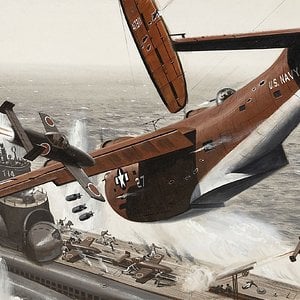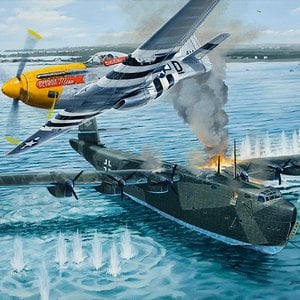Navigation
Install the app
How to install the app on iOS
Follow along with the video below to see how to install our site as a web app on your home screen.
Note: This feature may not be available in some browsers.
More options
You are using an out of date browser. It may not display this or other websites correctly.
You should upgrade or use an alternative browser.
You should upgrade or use an alternative browser.
Design
The Ki-67 was the result of a 1941 Japanese army specification for a successor to the Nakajima Ki-49. This new aircraft was specified to be a high-speed twin-engined heavy bomber suitable for possible conflicts with the Soviet Union over the Manchuria-Siberia border, and unlike many Japanese warplanes, was required to have good defensive armament and the ability to survive heavy battle damage. It was also required to be highly maneuverable allowing it to carry out dive-bombing attacks and escape at low level.[1][2] and was first encountered by Allied forces in a sea battle off Formosa in October 1944.
The Ki-67 was designed by a team led by Ozawa Kyonosuke, chief engineer at Mitsubishi, and was a mid-winged monoplane of all-metal construction, with a retractable tailwheel undercarriage. It was fitted with self-sealing fuel tanks and armor,[2][3] features common in US fighters and bombers but frequently lacking in Japanese aircraft. With these features and its two 1,417 kW (1,900 hp) 18-cylinder air-cooled radial engines, the Ki-67 was perhaps one of the most sturdy and damage-resistant Japanese aircraft of World War II.
The Ki-67's bomb load of 1,070 kg (2,360 lb) (carried in its internal bomb bay) would classify it as a medium bomber for the US (the B-25 Mitchell could carry up to 2,722 kg (6,000 lb), the B-26 Marauder up to 1,814 kg (4,000 lb), and the A-20 Havoc up to 907 kg (2,000 lb), for example). Its performance was remarkable compared to US medium bombers; the Ki-67 had a level-flight top speed of 537 km/h/334 mph (against 443 km/h/275 mph for the B-25, 462 km/h/287 mph for the B-26, and 538 km/h/338 mph for the A-20), good maneuverability in high-speed dives (up to nearly 644 km/h/400 mph), excellent sustained rate of climb, and outstanding ability to turn (excellent turn rate, small turn radius, and ability to turn at low speeds). The maneuverability of the Ki-67 was so good that the Japanese used the design as the basis for the Ki-109 twin-engine fighter, originally designed as a night fighter, and later for use as a daylight heavy fighter. In the last stages of World War II, the Japanese Navy also used the design as the basis for the Q2M1 "Taiyo" radar-equipped anti-submarine aircraft.
Another interesting feature of the Ki-67 was that the gun in the dorsal gunner's turret position was a 20 mm cannon. (In addition to twin 12.7 mm/0.5 in machine guns in the tail, one 12.7 mm/0.5 in gun in the nose, and one 12.7 mm/0.5 in gun at each waist-gun position.) The 20 mm cannon is an unusually powerful defensive armament for a bomber. Until the introduction of the B-29 Superfortress, US bombers seldom had cannons in defensive gunner positions, instead typically having one or two 12.7 mm (0.5 in) machine guns.
General characteristics
Crew: 6-8
Length: 18.7 m (61 ft 4¼ in)
Wingspan: 22.50 m (73 ft 9⅞ in)
Height: 7.70 m (25 ft 3⅛ in)
Wing area: 65.9 m² (709 ft²)
Empty weight: 8,649 kg (19,068 lb)
Max. takeoff weight: 13,765 kg (30,347 lb)
Powerplant: 2 × Mitsubishi Ha-104 (army type 4) 18-cylinder radials, 1,417 kW (1,900 hp)(take-off) each
Performance
Maximum speed: 537 km/h (290 knots, 334 mph) at 6,090 ft (20,000 ft)
Cruise speed: 400 km/h (217 knots, 249 mph) at 8,000 m (26,250 ft)
Range: 3,800 km (2,050 nmi, 2,360 mi)
Service ceiling: 9,470 m (31,070 ft)
Wing loading: 208 kg/m² (43 lb/ft²)
Power/mass: 0.21 kW/kg (0.13 hp/lb)
Climb to 6,000 m (19,700 ft):14 min 30 sec
Armament
Guns:
1 × 20 mm Ho-5 cannon in dorsal turret
5 × 12.7 mm Ho-103 (Type 1), one in nose, 2 in the tail, and 1 in each beam position
Bombs: 1600 kg (3527 lb) of bombs in internal bay or one torpedo, some Kamikaze versions carried 2,900 kg (6,400 lb) of bombs
The Ki-67 was the result of a 1941 Japanese army specification for a successor to the Nakajima Ki-49. This new aircraft was specified to be a high-speed twin-engined heavy bomber suitable for possible conflicts with the Soviet Union over the Manchuria-Siberia border, and unlike many Japanese warplanes, was required to have good defensive armament and the ability to survive heavy battle damage. It was also required to be highly maneuverable allowing it to carry out dive-bombing attacks and escape at low level.[1][2] and was first encountered by Allied forces in a sea battle off Formosa in October 1944.
The Ki-67 was designed by a team led by Ozawa Kyonosuke, chief engineer at Mitsubishi, and was a mid-winged monoplane of all-metal construction, with a retractable tailwheel undercarriage. It was fitted with self-sealing fuel tanks and armor,[2][3] features common in US fighters and bombers but frequently lacking in Japanese aircraft. With these features and its two 1,417 kW (1,900 hp) 18-cylinder air-cooled radial engines, the Ki-67 was perhaps one of the most sturdy and damage-resistant Japanese aircraft of World War II.
The Ki-67's bomb load of 1,070 kg (2,360 lb) (carried in its internal bomb bay) would classify it as a medium bomber for the US (the B-25 Mitchell could carry up to 2,722 kg (6,000 lb), the B-26 Marauder up to 1,814 kg (4,000 lb), and the A-20 Havoc up to 907 kg (2,000 lb), for example). Its performance was remarkable compared to US medium bombers; the Ki-67 had a level-flight top speed of 537 km/h/334 mph (against 443 km/h/275 mph for the B-25, 462 km/h/287 mph for the B-26, and 538 km/h/338 mph for the A-20), good maneuverability in high-speed dives (up to nearly 644 km/h/400 mph), excellent sustained rate of climb, and outstanding ability to turn (excellent turn rate, small turn radius, and ability to turn at low speeds). The maneuverability of the Ki-67 was so good that the Japanese used the design as the basis for the Ki-109 twin-engine fighter, originally designed as a night fighter, and later for use as a daylight heavy fighter. In the last stages of World War II, the Japanese Navy also used the design as the basis for the Q2M1 "Taiyo" radar-equipped anti-submarine aircraft.
Another interesting feature of the Ki-67 was that the gun in the dorsal gunner's turret position was a 20 mm cannon. (In addition to twin 12.7 mm/0.5 in machine guns in the tail, one 12.7 mm/0.5 in gun in the nose, and one 12.7 mm/0.5 in gun at each waist-gun position.) The 20 mm cannon is an unusually powerful defensive armament for a bomber. Until the introduction of the B-29 Superfortress, US bombers seldom had cannons in defensive gunner positions, instead typically having one or two 12.7 mm (0.5 in) machine guns.
General characteristics
Crew: 6-8
Length: 18.7 m (61 ft 4¼ in)
Wingspan: 22.50 m (73 ft 9⅞ in)
Height: 7.70 m (25 ft 3⅛ in)
Wing area: 65.9 m² (709 ft²)
Empty weight: 8,649 kg (19,068 lb)
Max. takeoff weight: 13,765 kg (30,347 lb)
Powerplant: 2 × Mitsubishi Ha-104 (army type 4) 18-cylinder radials, 1,417 kW (1,900 hp)(take-off) each
Performance
Maximum speed: 537 km/h (290 knots, 334 mph) at 6,090 ft (20,000 ft)
Cruise speed: 400 km/h (217 knots, 249 mph) at 8,000 m (26,250 ft)
Range: 3,800 km (2,050 nmi, 2,360 mi)
Service ceiling: 9,470 m (31,070 ft)
Wing loading: 208 kg/m² (43 lb/ft²)
Power/mass: 0.21 kW/kg (0.13 hp/lb)
Climb to 6,000 m (19,700 ft):14 min 30 sec
Armament
Guns:
1 × 20 mm Ho-5 cannon in dorsal turret
5 × 12.7 mm Ho-103 (Type 1), one in nose, 2 in the tail, and 1 in each beam position
Bombs: 1600 kg (3527 lb) of bombs in internal bay or one torpedo, some Kamikaze versions carried 2,900 kg (6,400 lb) of bombs








